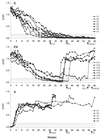Production of bovine herpesvirus type 1-seronegative latent carriers by administration of a live-attenuated vaccine in passively immunized calves
- PMID: 11060097
- PMCID: PMC87570
- DOI: 10.1128/JCM.38.11.4233-4238.2000
Production of bovine herpesvirus type 1-seronegative latent carriers by administration of a live-attenuated vaccine in passively immunized calves
Abstract
The consequences of the vaccination of neonatal calves with the widely used live-attenuated temperature-sensitive (ts) bovine herpesvirus type 1 (BHV-1) were investigated. The ts strain established acute and latent infections in all vaccinated calves either with or without passive immunity. Four of seven calves vaccinated under passive immunity became clearly BHV-1 seronegative by different serological tests, as did uninfected control calves after the disappearance of maternal antibodies, and they remained so for long periods. A cell-mediated immune response was detected by a BHV-1 gamma interferon assay, but this test failed to detect the seronegative latent carriers (SNLCs). While they are not detected, SNLCs represent a threat for BHV-1-free herds or countries. This study demonstrates that SNLCs can be easily obtained by inoculation with a live-attenuated BHV-1 under passive immunity and that latent carrier animals without any antibody do exist. Consequently, this situation could represent a good model to experimentally produce SNLCs.
Figures


Similar articles
-
Antibody Responses to Bovine Alphaherpesvirus 1 (BoHV-1) in Passively Immunized Calves.Viruses. 2019 Jan 2;11(1):23. doi: 10.3390/v11010023. Viruses. 2019. PMID: 30609738 Free PMC article. Review.
-
Latency and reactivation of a glycoprotein E negative bovine herpesvirus type 1 vaccine: influence of virus load and effect of specific maternal antibodies.Vaccine. 2001 Sep 14;19(32):4795-804. doi: 10.1016/s0264-410x(01)00212-2. Vaccine. 2001. PMID: 11535332
-
Effects of bovine herpesvirus type 1 infection in calves with maternal antibodies on immune response and virus latency.J Clin Microbiol. 2000 May;38(5):1885-94. doi: 10.1128/JCM.38.5.1885-1894.2000. J Clin Microbiol. 2000. PMID: 10790117 Free PMC article.
-
Rapid onset of protection following vaccination of calves with multivalent vaccines containing modified-live or modified-live and killed BHV-1 is associated with virus-specific interferon gamma production.Vaccine. 2003 Mar 7;21(11-12):1158-64. doi: 10.1016/s0264-410x(02)00560-1. Vaccine. 2003. PMID: 12559793 Clinical Trial.
-
A review of the biology of bovine herpesvirus type 1 (BHV-1), its role as a cofactor in the bovine respiratory disease complex and development of improved vaccines.Anim Health Res Rev. 2007 Dec;8(2):187-205. doi: 10.1017/S146625230700134X. Anim Health Res Rev. 2007. PMID: 18218160 Review.
Cited by
-
Seroprevalence of some Infectious transboundry diseases in cattle imported from Sudan to Egypt.J Adv Vet Anim Res. 2019 Feb 15;6(1):92-99. doi: 10.5455/javar.2019.f318. eCollection 2019 Mar. J Adv Vet Anim Res. 2019. PMID: 31453177 Free PMC article.
-
Assessment of BoAHV-1 Seronegative Latent Carrier by the Administration of Two Infectious Bovine Rhinotracheitis Live Marker Vaccines in Calves.Vaccines (Basel). 2024 Feb 3;12(2):161. doi: 10.3390/vaccines12020161. Vaccines (Basel). 2024. PMID: 38400144 Free PMC article.
-
Seroprevalence and Associated Risk Factors of Infectious Bovine Rhinotracheitis (IBR) and Animal Owners' Knowledge, Attitude and Practice (KAP) Towards the Disease in Selected Districts of East Wollega Zone, Oromia Regional State, Ethiopia.Vet Med Sci. 2024 Nov;10(6):e70043. doi: 10.1002/vms3.70043. Vet Med Sci. 2024. PMID: 39331486 Free PMC article.
-
Antibody Responses to Bovine Alphaherpesvirus 1 (BoHV-1) in Passively Immunized Calves.Viruses. 2019 Jan 2;11(1):23. doi: 10.3390/v11010023. Viruses. 2019. PMID: 30609738 Free PMC article. Review.
-
Calf health from birth to weaning. III. housing and management of calf pneumonia.Ir Vet J. 2011 Oct 21;64(1):14. doi: 10.1186/2046-0481-64-14. Ir Vet J. 2011. PMID: 22018053 Free PMC article.
References
-
- Ackermann M, Belak S, Bitsch V, Edwards S, Moussa A, Rockborn G, Thiry E. Round table on infectious bovine rhinotracheitis/infectious pustular vulvovaginitis virus infection diagnosis and control. Vet Microbiol. 1990;23:361–363. - PubMed
-
- Bradshaw B J, Edwards S. Antibody isotype responses to experimental infection with bovine herpesvirus 1 in calves with colostrally derived antibody. Vet Microbiol. 1996;53:143–151. - PubMed
-
- Brar J S, Johnson D W, Muscoplat C C, Shope R E J, Meiske J C. Maternal immunity to infectious bovine rhinotracheitis and bovine viral diarrhea viruses: duration and effect on vaccination in young calves. Am J Vet Res. 1978;39:241–244. - PubMed
-
- Denis M, Kaashoek M J, van Oirschot J T, Pastoret P-P, Thiry E. Quantitative assessment of specific CD4+ T lymphocyte proliferative response in bovine herpesvirus 1 immune cattle. Vet Immunol Immunopathol. 1994;42:275–286. - PubMed
-
- de Wit J J, Hage J J, Brinkhof J, Westenbrink F. A comparative study of serological tests for use in the bovine herpesvirus 1 eradication programme in The Netherlands. Vet Microbiol. 1998;61:153–163. - PubMed
Publication types
MeSH terms
Substances
LinkOut - more resources
Full Text Sources

